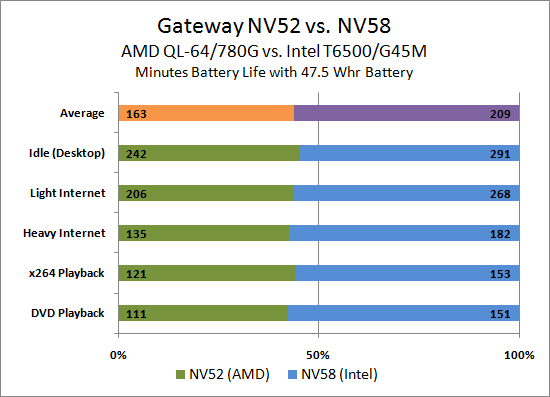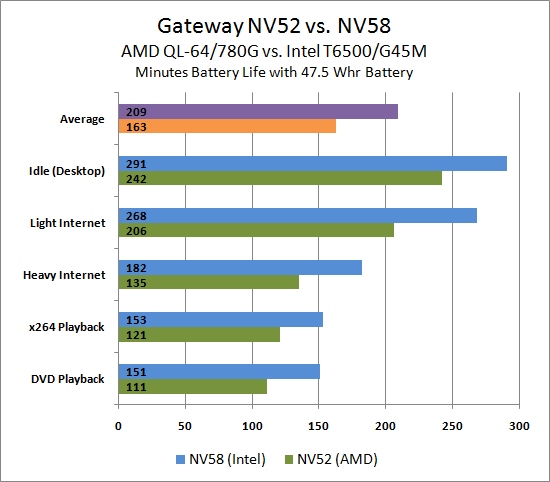Gateway AMD and Intel Laptops, a Platform Analysis
by Jarred Walton on August 12, 2009 2:00 AM EST- Posted in
- Laptops
Battery Life - AMD vs. Intel
We will start with a recap of our battery life testing. We are using a different format for the graphing than we used previously, so you can look at the other article if you prefer our "normal" graphs. For this chart, equal performance is denoted by the 50% mark in the middle of the chart. A larger bar means better performance, and the numerical results (in minutes) are available for those that prefer raw numbers.

We've already discussed this, but simply put Intel walks away with the battery life crown. On average, the Intel system offers 28% more battery life than AMD, with the closest result at Idle (20%).
We have heard several potential "solutions" for the poor AMD battery life - use one of the Turion X2 Ultra CPUs that have split power planes, for example, which should indeed help matters. However, we are comparing relatively similar offerings; after all, Intel also offers many CPUs that should provide better battery life than the T6500. The P8400 is one example, offering a lower 25W TDP, 50% more L2 cache, and a higher clock speed and FSB.
Undervolting is another suggestion, and one that definitely can improve idle battery life. If you consider the equation:
P = C * F * V2
(Power = Capacitance * Frequency * Voltage Squared)
…reducing the voltage of a chip can greatly improve power requirements. Like overclocking, however, undervolting is not guaranteed, requires the use of additional utilities, and you have to compare undervolted chips to each other. Undervolting an AMD chip might help to match a stock voltage Intel chip, but it's very likely both will be able to achieve lower voltages than what Intel specifies. (We will try to take a closer look at undervolting in the future.) The net result is that we truly don't see AMD closing the gap with Intel until they come out with a built-from-the-ground-up mobile architecture.
Okay, we already knew that the battery life comparison would favor Intel. We'll have a closer look at why this is in a moment when we look at power consumption. First, let's look at the rest of the performance spectrum.
Update
For those that prefer a more traditional presentation, here's a second graph showing the same data as the above chart. Also, the data labels got reversed at some point; the graphs are now both correct - sorry for the confusion.











67 Comments
View All Comments
7Enigma - Wednesday, August 12, 2009 - link
Agreed. People are not going to be gaming on the latest (or even last-gen FPS') but most certainly would probably be doing MMO games. And of all the games The Sims (2 or 3) should be included. That is probably the largest non-MMO game out there for the casual gamer, of which these laptops are perfectly suited.KidneyBean - Wednesday, August 12, 2009 - link
Or how about Source games like Half-Life 2, Team Fortress 2, and Counter-Strike 2?Those should run faster than the latest FPS.
hyc - Wednesday, August 12, 2009 - link
Very few vendors actually sell comparable models of AMD and Intel notebooks. I don't think HP's dv5z (which I own, and is already discontinued) is really comparable to their dv5t.And I've yet to find anyone selling an AMD laptop with 15.4" WUXGA screen. So far the only possibilities have been Dell or Lenovo, and they're all Intel. It's pathetic that AMD has the best graphics cards now but you can't get an AMD combo paired with the best screens.
Show me an AMD notebook with 15.4" WUXGA LED-backlit screen. (Oh, and backlit keyboard too, please.) I'll buy it. I'm sick of seeing AMD designs getting the poor cousin treatment, I want all the same top notch feature choices the Intel models get...
strikeback03 - Thursday, August 13, 2009 - link
You realize you can get an AMD discrete GPU with an Intel CPU/chipset, right? Which this article has shown that the GPU is really the only part of the AMD system worth owning.cactusdog - Wednesday, August 12, 2009 - link
Nice review, it answered some questions i had.cfaalm - Wednesday, August 12, 2009 - link
Talking about a price premium over a $ 500 - 580 notebook:
damianrobertjones - Wednesday, August 12, 2009 - link
Or if Dailytech really isn't one sided towards Apple, then maybe the reviewer could also add a Linux build to the scene.. Standard laptop, linux.. what would the battery life be?????hyc - Wednesday, August 12, 2009 - link
Likely worse on the AMD system. At least, the open source ATI drivers' support for power management still doesn't handle all of the power save features that the chipset offers.medi01 - Wednesday, August 12, 2009 - link
Why not compare to intel notebook with nvidia graphic card?samspqr - Wednesday, August 12, 2009 - link
the labels on the x axis of the power consumption graph are completely deceiving